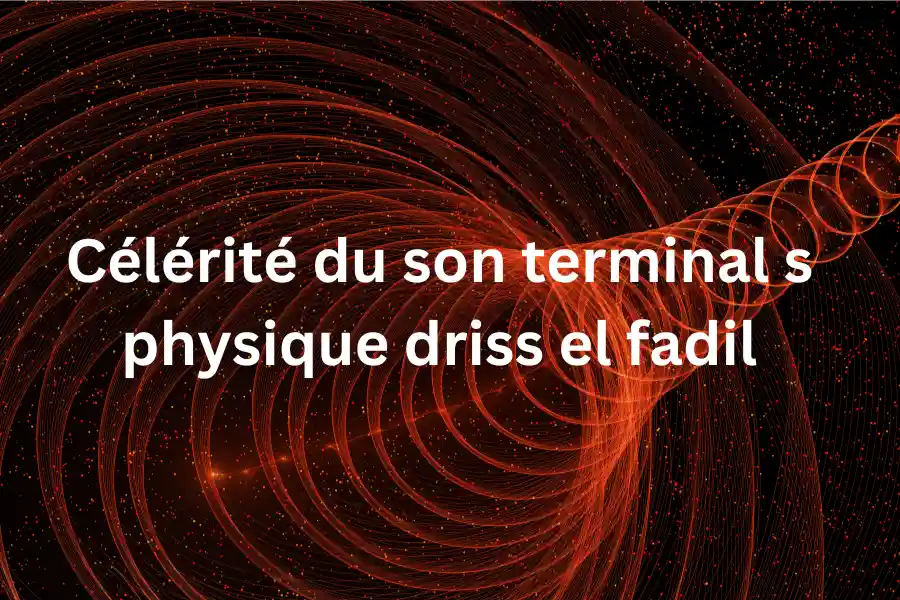Welcome to the exciting world of célérité du son terminal s physique Driss El Fadil! Imagine sound moving through the air, like ripples in water, going through different materials at different speeds. Célérité s, or the speed of sound in a fixed material, shows us a hidden world of vibrations in different stuff.
In this blog, we’ll explore what célérité du son terminal s physique Driss El Fadil is, how it’s helpful in things like medical imaging, and the incredible discoveries by Driss El Fadil, a clever scientist from Morocco. Join us for a fun journey into the science of sound, where we discover how sound travels in solids and how Driss El Fadil has changed how we understand it.
Get ready for an adventure where célérité du son terminal s physique Driss El Fadil dances to the beat of each material!
What is célérité du son terminal s physique driss el fadil?

Célérité du son terminal s physique Driss El Fadil, or célérité s, is the speed of sound in a fixed physical medium, measured in meters per second (m/s). Driss El Fadil’s work delves into how this speed is influenced by the medium’s properties, such as density and elasticity, with the formula c = √(E/ρ). The modulus of elasticity reflects a material’s stiffness, while density measures its mass per unit volume.
Generally, sound travels faster in solids due to their higher density and modulus of elasticity compared to liquids and gases. For example, sound in steel moves at 5,960 m/s, water at 1,480 m/s, and air at 343 m/s. Driss El Fadil’s contributions provide valuable insights into these principles and their practical applications, offering a deeper understanding of sound wave behavior in various materials.
Who is Driss El Fadil?
Driss El Fadil, a distinguished Moroccan physicist, has made significant contributions to célérité du son terminal s physique, or célérité s. His expertise is understanding how sound behaves in fixed physical mediums, revealing a unique world distinct from airborne sound. Recognized by the Moroccan Academy of Sciences and Techniques, El Fadil’s research explores sound interactions with materials like metals, wood, and bone.
His work has practical applications in sonar technology, medical imaging (ultrasound and elastography), and nondestructive testing for infrastructure safety. Beyond research, El Fadil actively mentors scientists, fostering a passion for physics and ensuring the ongoing exploration of sound secrets in solids for future generations.
Applications of célérité du son terminal s physique driss el fadil

Célérité du son terminal s physique Driss El Fadil, or célérité s, involves understanding the speed of sound in a fixed physical medium. This concept has numerous applications across diverse fields:
Sonar Technology: Célérité s is integral to sonar, a system that uses sound waves for underwater object detection and location. By measuring the time it takes for sound waves to travel, the distance to the object can be calculated.
Medical Imaging Techniques: In medical imaging, including ultrasound and elastography, célérité s aids in creating images of the body’s interior. By measuring sound wave travel times, distances to targets can be calculated to produce detailed images of organs and tissues.
Nondestructive Testing (NDT): Célérité s plays a crucial role in NDT methods, particularly ultrasonic testing. By measuring sound wave travel times in materials like metals and concrete, defects can be detected without causing damage.
Seismology: The study of earthquakes and seismic waves, seismology utilizes célérité s to determine the Earth’s interior structure by understanding the speed of sound in different materials.
Material Characterization: Célérité s is used to characterize properties such as density, elasticity, and porosity, aiding in material selection for specific applications.
Acoustic Communication: Acoustic communication, utilizing sound waves for information transmission, employs célérité s in underwater communication, sonar, and medical imaging applications.
Flow Measurement: The speed of sound in fluids is applied to measure flow rates in water, oil, and gas, contributing to applications like flow engineering.
Level Measurement: Célérité s in fluids is employed to measure levels in tanks, rivers, and oceans, facilitating tank level measurement and environmental monitoring applications.
Leak Detection: Célérité s in gases is utilized for leak detection in pipelines, air conditioning, and refrigerant systems, enhancing safety and efficiency.
Gas Composition: Determining gas composition is achieved through célérité s, which is applicable in measuring the composition of natural gas, biogas, and industrial gases.
Célérité du son terminal s physique Driss El Fadil work advances our understanding of sound in solids. It contributes to various practical applications across different scientific and technological domains.
Also Read: https://diagonaux.com/what-is-geoe-best-facts-you-should-know-in-2024/
Why is it important?
Célérité du son terminal s physique Driss El Fadil, is more than just a cool science thing; it’s super useful in our daily lives! It helps doctors see inside our bodies with ultrasound, and it’s the reason why we can find stuff underwater using sonar. It also ensures our buildings and things are safe by checking for problems without breaking them. Célérité s is like a superhero for technology, allowing us to talk through walls, measure how liquids flow, and choose the best materials for different jobs.
But it’s not just about being practical; it’s like a magical journey into sound and materials, opening up possibilities for cool things like making better materials and robots. So, célérité s isn’t just a tool; it’s like discovering the fabulous music of how sound works in our world.
Future of Célérité du son terminal s physique Driss El Fadil

The future of célérité du son terminal s physique Driss El Fadil (célérité s), holds great potential for innovation. Advancements in understanding how sound interacts with materials may lead to next-gen medical imaging for improved disease diagnosis and treatment. Enhanced non-destructive testing methods could ensure safer critical infrastructure, while célérité s might revolutionize communication technologies, enabling data transmission through solids.
The technology could also contribute to developing superior materials with advanced properties, impacting durability and conductivity. Breakthroughs in acoustic engineering, such as improved noise cancellation and contributions to our understanding of the universe by studying sound in different materials, showcase the exciting possibilities ahead.
FAQs
What is Célérité du son terminal s physique Driss El Fadil?
Célérité du son terminal s physique, or célérité s, is the speed of sound in a fixed medium. Driss El Fadil, a physicist, has advanced our understanding of this concept, uncovering the intricacies of sound in various materials.
How does célérité s impact medical imaging?
Célérité s is crucial for medical imaging, like ultrasound, providing detailed insights into tissues and organs for diagnostics and treatment.
What role does célérité s play in non-destructive testing (NDT)?
In NDT, célérité s is essential for ultrasonic testing, allowing engineers to detect material flaws without damage, ensuring infrastructure safety.
Can célérité s revolutionize communication technologies?
Yes, célérité s holds the potential to transform communication by enabling data transmission through solid materials.
How might célérité s advance acoustic engineering?
Célérité s could significantly advance acoustic engineering, influencing noise cancellation and the development of new acoustic sensors, enhancing technology efficiency.
Conclusion-(Célérité du son terminal s physique Driss El Fadil)
In short, célérité du son terminal s physique Driss El Fadil, isn’t just about how fast sound travels—it’s about exciting possibilities. It helps doctors see inside our bodies better, ensures buildings are safe, and might even change how we talk through walls! Driss El Fadil’s work is like a superhero for technology, making medical pictures more explicit, ensuring things are safe, and opening the door to new ways of communication. The future looks promising, with célérité s leading the way in improving technology and helping us understand more about the world around us.
If you want to learn more, visit our blog, diagonaux.com.

Hi there! I’m Admin and writer at Diagonaux.com, with over 30 years of experience. I love playing with words, whether it’s covering news, diving into business topics, or creating beautiful poems and stories. Making complex things easy to understand is my superpower. Join me on this writing journey, where I bring words to life in various exciting ways!





Leave a Reply